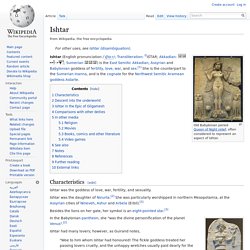

Demeter. In ancient Greek religion and myth, Demeter (/diˈmiːtər/; Attic: Δημήτηρ Dēmḗtēr; Doric: Δαμάτηρ Dāmā́tēr) is the goddess of the harvest, who presided over grains and the fertility of the earth.

Her cult titles include Sito (Σιτώ), "she of the Grain",[1] as the giver of food or grain[2] and Thesmophoros (θεσμός, thesmos: divine order, unwritten law; "phoros": bringer, bearer), "Law-Bringer," as a mark of the civilized existence of agricultural society.[3] Etymology[edit] Demeter's character as mother-goddess is identified in the second element of her name meter (μήτηρ) derived from Proto-Indo-European *méh₂tēr (mother).[11] In antiquity, different explanations were already proffered for the first element of her name.
An alternative, Proto-Indo-European etymology comes through Potnia and Despoina; where Des- represents a derivative of PIE *dem (house, dome), and Demeter is "mother of the house" (from PIE *dems-méh₂tēr).[20] Dewi Sri. The depiction of Dewi Sri in Central Java art Attributes and legends[edit] Dewi Sri is believed to have dominion over the underworld and the Moon.

Thus, Dewi Sri encompasses the whole spectrum of the Mother Goddess- having dominion over birth and Life: she controls rice: the staple food of Indonesians; hence life and wealth or prosperity; most especially rice surpluses for the wealth of kingdoms in Java such as Mataram, Majapahit and Pajajaran; and their inverse: poverty, famine, hunger, disease (to a certain extent) and Death. She is often associated with the rice paddy snake (ular sawah). Gaia (mythology) The Greek word γαῖα (transliterated as gaia) is a collateral form of γῆ[4] (gē, Doric γᾶ ga and probably δᾶ da)[5] meaning Earth,[6] a word of uncertain origin.[7] R.

S. P. Beekes has suggested a Pre-Greek origin.[8] In Mycenean Greek Ma-ka (trans. as Ma-ga, "Mother Gaia") also contains the root ga-.[9][10] According to Hesiod, Gaia conceived further offspring with Uranus, first the giant one-eyed Cyclopes: Brontes ("Thunder"), Steropes ("Lightning") and Arges ("Bright");[16] then the Hecatonchires: Cottus, Briareos and Gyges, each with a hundred arms and fifty heads.[17] As each of the Cyclopes and Hecatonchires were born, Uranus hid them in a secret place within Gaia, causing her great pain. Because Cronus had learned from Gaia and Uranus, that he was destined to be overthrown by his own child, Cronus swallowed each of the children born to him by his Titan sister Rhea.
With Gaia's advice[21] Zeus defeated the Titans. In classical art Gaia was represented in one of two ways. Inanna. Inanna (/ɪˈnænə/ or /ɪˈnɑːnə/; Cuneiform: 𒀭𒈹

Ishtar. Ishtar (English pronunciation /ˈɪʃtɑːr/; Transliteration: DIŠTAR; Akkadian: 𒀭𒈹 ; Sumerian 𒀭𒌋𒁯) is the East Semitic Akkadian, Assyrian and Babylonian goddess of fertility, love, war, and sex.[1] She is the counterpart to the Sumerian Inanna, and is the cognate for the Northwest Semitic Aramean goddess Astarte.

Nokomis. Persephone. Persephone as a vegetation goddess and her mother Demeter were the central figures of the Eleusinian mysteries that predated the Olympian pantheon and promised the initiated a more enjoyable prospect after death.

Persephone is further said to have become by Zeus the mother of Dionysus, Iacchus, or Zagreus, usually in orphic tradition. The origins of her cult are uncertain, but it was based on very old agrarian cults of agricultural communities. Name[edit] Etymology[edit] Persephone or "the deceased woman" holding a pomegranate. Persephatta (Περσεφάττα) is considered to mean "female thresher of corn," going by "perso-" relating to Sanskrit "parsa", "sheaf of corn" and the second constituent of the name originating in Proto-Indo European *-gʷʰn-t-ih, from the root *gʷʰen "to strike".[8] Phra Mae Thorani. Phra Mae Thorani (Thai: พระแม่ธรณี), Mae Phra Thorani (Thai: แม่พระธรณี) or Nang Thorani (นางธรณี), known as Wathondara (ဝသုန္ဒရာ) or Wathondare (ဝသုန္ဒရေ) in Burmese, from Pali Vasudhara[n 1]) are Thai and Lao language names for the Khmer language Preah Thorani (Khmer: ព្រះធរណី ឬ នាងគង្ហីងព្រះធរណី), an earth goddess of the Buddhist mythology of the region.

She is also known as Suvathara or Sowathara. Rhea (mythology) Rhea (or Cybele), after a marble, 1888.

Then she hid Zeus in a cave on Mount Ida in Crete. According to varying versions of the story: Rhea only appears in Greek art from the fourth century BC, when her iconography draws on that of Cybele; the two therefore, often are indistinguishable;[10] both can be shown on a throne flanked by lions, riding a lion, or on a chariot drawn by two lions. In Roman religion, her counterpart Cybele was Magna Mater deorum Idaea, who was brought to Rome and was identified in Roman mythology as an ancestral Trojan deity.
On a functional level, Rhea was thought equivalent to Roman Ops or Opis.